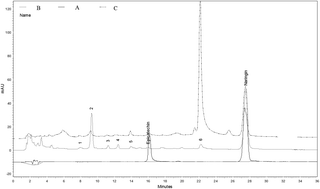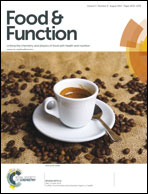Protective effects of Drynaria fortunei against 6-hydroxydopamine-induced oxidative damage in B35 cells via the PI3K/AKT pathway
Abstract
In this study, we demonstrate the antioxidant and protective properties of the aqueous extract of two commercial Polydiaceae plants – Drynaria fortunei (DF) and Pseudodrynaria coronans (PC) against 6-hydroxydopamine (6-OHDA)-induced oxidative damage in B35 neuroblastoma cells. The contents of their phytochemical profiles were determined by spectrophotometric methods and high performance liquid chromatography using a photodiode array detector. DF extract showed better effects than PC extract in scavenging ROS and inhibiting 6-OHDA autoxidation. Following exposure to 6-OHDA, B35 cells showed a marked decrease in cell survival and the activation of intracellular antioxidant enzymes and the PI3K/AKT pathway, and then an increased level of lipid peroxidation. Pretreatment with DF extract blocked these 6-OHDA-induced cellular events. Naringin and epicatechin are major components of DF extract. These results show that DF extract exerts protective effects against 6-OHDA toxicity via radical scavenging activity and an increase in the activation of the PI3K/AKT pathway to elevate the levels of intracellular antioxidant enzymes including HO-1, NQO-1 and glutathione-related enzymes.


 Please wait while we load your content...
Please wait while we load your content...